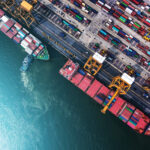Staying competitive in an interconnected world
Staying competitive in an interconnected world
The modernisation of customs and the globalisation of our interconnected world are bringing significant benefits to companies involved in freight forwarding and supply chain management.
The import and export of goods into and from South Africa have grown considerably over the last decade. Whilst this growth can be attributed to a plethora of reasons, one significant contributory factor is the advent of customs modernisation, whereby several non-tariff barriers have been broken down. This has made it easier for current and potential traders to import and export their goods with less bureaucracy, reduced risk, greater efficiency, and enhanced predictability.
For an illustrative and informed insight into customs modernisation benefits, one need only look at a simple comparison between the processing of customs declarations as we know it today, compared to pre-customs modernisation. Upon closer inspection, it quickly becomes apparent that a substantial reduction in declaration processing times aligns exactly with the simplification of procedures.
Prior to the roll-out and introduction of customs modernisation in South Africa, a customs broker would, depending on the type of transaction, manually complete the DA25, DA26, DA28, or DA29 forms in triplicate carbon, work out the duties and taxes payable to SARS, and endorse the computations therein before hand-delivering the bill of entry (customs declaration) to the appropriate SARS branch office for assessment. The broker would place the declaration in the allocated box or cubicle, allowing a few days for the appointed customs officer to make a decision. Based on the accuracy of the information contained therein, the officer would then either release, reject, or detain the declared shipment. The assessed entry would subsequently be placed in a cubicle for collection by the customs broker, with no prior indication of the resultant assessment status.
In stark contrast to this – what some may consider a rather primitive procedure – customs brokers now have access to time-saving and productivity-enhancing tools that have been developed to ensure the roll-out of customs modernisation, accompanied by evolved procedures and processes.
Today, the SAD500 customs declaration is processed by an entry clerk, with the aid of a computer software application. All duties and taxes are computed electronically and, once the customs entry is rated, it is submitted to SARS Customs via an Electronic Data Interchange platform along with an assessment result (CUSRES Code Message). This result, which previously took several days to process, is now received within a few minutes of submitting the declaration.
Globalisation brings with it an increasingly complex, interconnected world, as reflected by the expanded flow of goods, people, capital, information, and technology. It makes sense that the relationship between customs modernisation and international trade can be regarded as symbiotic – an initial growth in international trade warranted the development of a modernised customs administration in South Africa, while as processes became easier, international trade experiences inevitably improved.
The evolution of this symbiotic relationship means that it is becoming increasingly easy to conduct business internationally; countries now have the opportunity to fast-track economic growth and development through increased international trade. This is not only beneficial to legitimate trade, however, but also benefits illegal trade. Criminals are making use of more integrated markets and the freer movement of people to illicitly move goods, people, and money across international borders.
In the words of the late Steve Jobs, change is inevitable. This is as it should be: change is a vital agent of renewal in life, clearing out the old to make way for the new. We need, therefore, to explore and invest in current and future developments in processes, procedures, and technology that allow our businesses to remain competitive and grow consistently in an ever-changing environment.
To achieve progress and evolve your business into enhanced efficiency, efficacy, and exponential growth, there are four crucial characteristics in particular to explore and invest in: togetherness, empowerment, collaboration, and habit. These are the characteristics for shifting the business tide and surfing on the waves of change.
Togetherness and purpose are very closely related. Companies need to have a clear goal and must be able to prove their relevance, both to clients and collaborators.
In terms of empowerment, it is easy to understand that just as customs modernisation required capacity building, so too must businesses upskill and train their staff to align with the current industry demands.
Collaboration, meanwhile, has been and remains essential to the success of customs modernisation initiatives. Similarly, strategic partnerships between your business and service providers, clients, and acquaintances are pivotal to continuous business growth and development.
Finally, let’s take a look at the key characteristic we refer to as “habit”. The definition of habit is “a settled or regular tendency or practice, especially one that is hard to give up”. Notwithstanding the importance of the three preceding characteristics, habit is imperative to ensure the steadfast delivery of unparalleled discipline and consistency in managing client expectations, service provider relationships, and a productive, healthy, and happy employee-employer environment.
In the words of Barack Obama: “Change will not come if we wait for some other person or some other time. We are the ones we’ve been waiting for. We are the change that we seek.”
Published by
Devlyn Naidoo
focusmagsa




